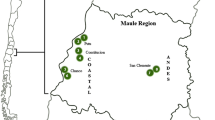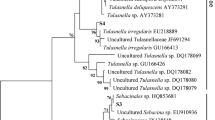Abstract
Symbiotic germination was analyzed in the myco-heterotrophic orchid Gastrodia elata. Seeds were placed on water agar medium containing a leaf-disc of Quercus accutissima that had been previously inoculated with one of six different Mycena species. Among the six fungi, KFRI1212 (HQ662845) and KFRI2121 (HQ662846) germinated 60.1 and 47.0 % seeds, respectively, while others germinated less than 3.5 %. Although KFRI1212 induced a significantly higher germination rate than KFRI2121, initiation of protocorm development was induced much faster by KFRI2121 than by KFRI1212. Molecular identification and phylogenetic analysis showed that the two fungi belonged to one clade that includes Mycena chlorophos, M. amicta and M. tenerrima, suggesting that seed germination of G. elata depends on a narrow taxonomic range of fungi. In conclusion, this study not only showed fungal preference of G. elata for seed germination but also confirmed molecular identities of mycorrhizal fungi for the first time, which will allow us to better understand the process of symbiotic events at the germination stage of G. elata.



Similar content being viewed by others
References
Arditti J, Ernst R, Yam TW, Glabe C (1990) The contribution of orchid mycorrhizal fungi to seed germination: a speculative review. Lindleyana 5:249–255
Cannon PF, Kirk PM (2007) Fungal families of the world. CABI, Wallingford
Chang HM, But PH (1986) Pharmacology and application of Chinese materia medica, vol 1. World Scientific, Singapore
Gardes M, Bruns TD (1993) ITS primers with enhanced specificity for basidiomycetes—application to the identification of mycorrhizae and rusts. Mol Ecol 2:113–118
Huang ZL (1985) Pharmacologic studies and clinical applications of Gastrodia elata Bl. J Mod Dev Tradit Media 5:251–254
Kumar S, Nei M, Dudley J, Tamura K (2008) MEGA: a biologist-centric software for evolutionary analysis of DNA and protein sequences. Brief Bioinform 9:299–306
Kusano S (1911) Gastrodia elata and its symbiotic association with Armillaria mellea. Imp Univ Tokyo J Coll Agric 4:1–65
Martin KJ, Rygiewicz PT (2005) Fungal-specific PCR primers developed for analysis of the ITS region of environmental DNA extracts. BMC Microbiol 5:28–38
McKendrick SL, Leake JR, Taylor DL, Read DJ (2000) Symbiotic germination and development of myco-heterotrophic plants in nature: ontogeny of Corallorhiza trifida and characterisation of its mycorrhizal fungi. New Phytol 145:523–537
McKendrick SL, Leake JR, Lee Taylor D, Read DJ (2002) Symbiotic germination and development of the myco-heterotrophic orchid Neottia nidus-avis in nature and its requirement for locally distributed Sebacina spp. New Phytol 154:233–247
Millner HJ, Obeng A, McCrea AR, Baldwin TC (2008) Axenic seed germination and in vitro seedling development of Restrepia brachypus (Orchidaceae). J Torrey Bot Soc 135:497–505
Otero JT, Ackerman JD, Bayman P (2004) Differences in mychorrhizal preferences between two tropical orchids. Mol Ecol 13:2393–2404
Otero JT, Ackerman JD, Bayman P (2005) Variation in mychorrhizal performance in the epiphytic orchid Tolumnia variegata in vitro: the potential for natural selection. Evol Ecol 19:29–43
Ogura-Tsujita Y, Gebauer G, Hashomoto T, Umata H, Yukawa T (2009) Evidence for novel and specialized mycorrhizal parasitism: the orchid Gastrodia confusa gains carbon from saprotrophic Mycena. Proc R Soc Lond B 276:761–767
Rasmussen HN (1995) Terrestrial orchids from seed to mycotrophic plant. Cambridge University Press, Cambridge
Rasmussen HN, Rasmussen FN (2009) Orchid mycorrhiza: implications of a mycophagous life style. Oikos 118:334–345
Sharma J, Zettler LW, van Sambeek JW, Ellersieck MR, Starbuck CJ (2003) Symbiotic seed germination and mycorrhizae of federally threatened Platanthera praeclara (Orchidaceae). Am Midl Nat 149:104–120
Taylor DL, Bruns TD, Leake JR, Read DJ (2002) Mycorrhizal specificity and function in myco-heterotrophic plants. In: van der Heijden MGA, Sanders I (eds) Mycorrhizal ecology, vol 157. Springer, Berlin, pp 375–413
Xu JT, Guo SX (1991) The relationship of nutrient between Gastrodia elata–Mycena osmundicola and Armillaria mella and its application in the cultivation. J Med Res 1:31–32
Xu JT, Guo SX (2000) Retrospect on the research of the cultivation of Gastrodia elata Bl, a rare traditional Chinese medicine. Chin Med J 113:686–692
Xu JT, Ran YZ, Mou C, Wang CF, Cao JM, Wang M, Lu JZ (1981) A brief report on the nutritious sources of seed germination of Gastrodia elata. Bull Chin Mater Med 6:2
Author information
Authors and Affiliations
Corresponding author
Rights and permissions
About this article
Cite this article
Park, EJ., Lee, W.Y. In vitro symbiotic germination of myco-heterotrophic Gastrodia elata by Mycena species. Plant Biotechnol Rep 7, 185–191 (2013). https://doi.org/10.1007/s11816-012-0248-x
Received:
Accepted:
Published:
Issue Date:
DOI: https://doi.org/10.1007/s11816-012-0248-x




